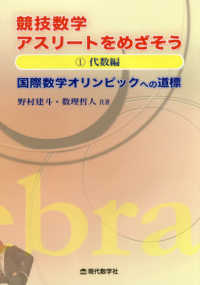- ホーム
- > 洋書
- > 英文書
- > History / World
Full Description
Archaeological evidence for settlement and land use in early medieval Scottish upland landscapes remains largely undiscovered. This study records only the second excavation of one important and distinctive house form, the Pitcarmicktype building, in the hills of north-east Perth and Kinross. Excavation of seven turf buildings at Lair in Glen Shee has confirmed the introduction of Pitcarmick buildings in the early 7th century AD. Clusters of these at Lair, and elsewhere in the hills, are interpreted as integrated, spatially organised farm complexes comprising byre-houses and outbuildings. Their form has more to do with contemporary traditions across the North Sea than with local styles.
There is a close link between 7th-century climatic amelioration and their spread across the hills, and it is argued that this was a purposeful re-occupation of a neglected landscape. Pitcarmick buildings were constructed and lived in by precocious, knowledgeable, and prosperous farming communities. Pollen analysis has shown the upland economy to have been arable as well as pastoral, and comparable contemporary economic 'recovery' is suggested from similar analyses across Scotland. The farms at Lair were stable and productive until the 11th century when changes, poorly understood, saw their demise.
Contents
List of Figures
List of Tables
Acknowledgements
List of Contributors
Notes
1. Introduction (Strachan and Tipping)
1.1 Background to the project
1.2 North-west European turf and timber houses: an international context for the excavations at Lair
1.3 The archaeological setting
1.4 Pollen-analytical evidence for land-use change in and around Glen Shee
1.5 Historical and political contexts
1.6 The Pictish language and place-names in and around Glen Shee
1.7 The catchment of the Allt Corra-lairige: geology, topography, soils and climate
1.8 Mapping of the field remains
1.9 Key sites in the study area
1.10 Research objectives
2. Results of Archaeological Fieldwork, Radiocarbon Dating, Peat-Stratigraphic and Pollen Analyses (Sneddon, Strachan and Tipping)
2.1 Introduction
2.2 Topographic and geophysical survey
2.3 Excavation
2.4 Geo-archaeological analyses
2.5 Radiocarbon dating
2.6 Peat-stratigraphic and pollen-analytical evidence for environmental and land-use change
2.7 Charcoal analysis
3. The Small Finds (Strachan and Sneddon)
3.1 Introduction
3.2 Lithics
3.3 Stone tools
3.4 A decorated stone spindle whorl
3.5 The iron objects
3.6 The vitrified material
3.7 The pottery
3.8 The glass bead
3.9 Animal bone
4. Discussion (Strachan, Tipping and Sneddon)
4.1 Introduction
4.2 Archaeological and pollen-analytical evidence for later prehistoric settlement and use of the uplands
4.3. A Late Iron Age-early medieval settlement continuum?
4.4 Lair immediately prior to the construction of the Pitcarmick buildings
4.5 Chronology and sequence of the buildings at Lair
4.6 The buildings at Lair: form and function
4.7 The buildings at Lair: turf, stone, timber and thatch
4.8 The buildings at Lair: spatial patterning
4.9 Re-visiting the morphology of Pitcarmick buildings
4.10 Early medieval buildings in the North Sea area
4.11 The socio-political context and geographic patterns of Pitcarmick buildings in north-east Perthshire
4.12 The rural economy at Lair AD 600-660 to AD 975-1025: palynological evidence and implications
4.13 The wider context of 7th century AD agrarian expansion
4.14 The function of Pitcarmick buildings
4.15 The social status of 'Pitcarmick' communities
4.16 After the 'Pitcarmicks'
5. Conclusions
5.1 Introduction
5.2 Threats to the resource
5.3 The impact of the Glenshee Archaeology Project
5.4 Lessons learned
5.5 Potential for future research
References
Appendix A
Index








